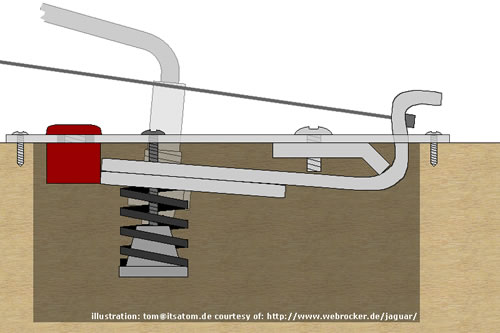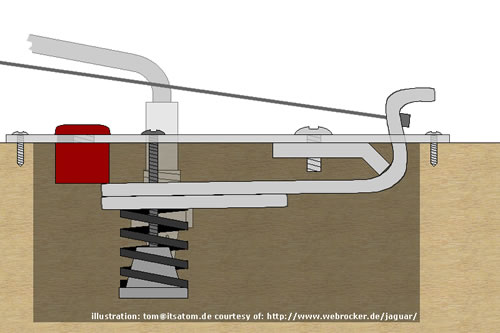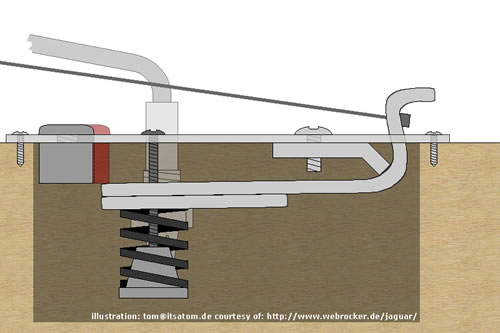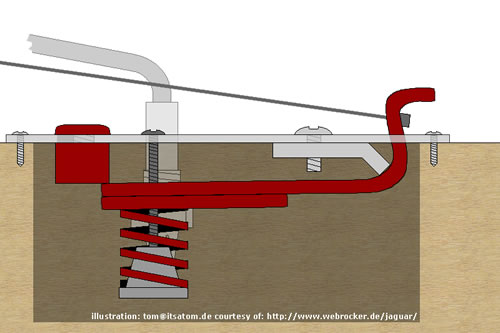Setting up the Tremolo-System
This feature is about the Jaguar’s and Jazzmaster’s tremolo system, one of the smoothest and tuning-stable systems out there. It is not designed for “dive-bombs”, but within normal range it’s ace. Plus it has the unique “trem-loc” feature – a feature that many people just don’t know about. I came across several guitar repair/maintenance guys who just didn’t know what this feature is about. Time to change that. :-)
First let’s have a look “under the hood”:
Now, on to the function of these metal-thingies…
I intend to setup the tremolo as described by Fender, so that the lock feature will work. This feature works like a mechanical memory of the tuned state of the guitar. If a string breaks, normally the missing pull of that string forces tremolo systems out of tune, usually the whole tuning goes sharp. That is because the balance between the tremolo’s spring and the pull of the strings has shifted – the spring is now stronger in comparison to the pull and forces the strings to go sharp.
Fender designed the Jag and JM tremolo so that with a simple slide of a knob the “right” tuning is restored – the tremolo works downward only when the lock is engaged.
Here are the components important for the setup:

All we need is a tuner, a philips screwdriver and some patience. Turning the adjustment screw will alter the tuning, so several rounds of turning and retuning are necessary.
First, setup all other factors of the guitar (intonation, action, neck curve) before setting up the tremolo (see the setup tips and the troubleshoot-list if unsure).
Then tune the guitar to pitch. With the screwdriver, turn the adjustment screw so that you just cannot engage the tremlock (by sliding the tremlock button towards the tremolo, away from the bridge). With a minimal push on the tremarm downward, sliding in the lock should be possible.
Too tight…

… you cannot engage the lock, neither in pitch tuning nor with a broken string.
Too loose…

… sliding in and out has no effect on the tuning, but if a string would break, the system will go sharp, even with the lock engaged.
Perfect:

Perfect, because the system remains the same position with the lock on or off:

Now, tune the guitar, and fine-adjust the tremolo setting so that you can slide the knob in and out without theoretically altering the guitar’s tuning. It may take some times of turning and tuning, I recommend a quarter-turn each time. The desired state is that with the lock engaged, the tuning is minimal flat (if you have a “in pitch” position, which is theoretical the desired, you may get some buzz when the lock is engaged. so a mini bit of “push” from the spring on the lock is ok).
If a string breaks, the system will go sharp…

…because the spring and the strings are out of balance.
Now, simply push the tremolo arm down, and engage the lock – you’ll return the system to the tuned state immediately, because the tremlock forces the system back in the right position:

And there we are. If you play occasionally with a altered tuning (dropped d-tuning for example) you will love this feature. At least so do I. :-)
Note: Some vintage systems seem to have very strong springs, so that the “balanced” position will not be possible even with the tension loosened as far as possible. This happens usually with string sets lighter than .11s (.10s on the JM).
Contrary to that, some Japanese models seem to have springs that are too light to handle stronger strings. (.11s and up).
-- Tom Arnold, August 2002 (updated January 2004)
[Update June 2007] German “Gitarre & Bass” magazine has kindly asked if I would translate and submit this article for their July issue, which features a large article about the Fender Jazzmaster. I did so, and now it’s printed. Hooray. :-)
[Update April 2017] American "Premier Guitars Magazine" uses some of the illustrations for a set up article in their May 2017 issue, available online and in print. Even more hooraoy :-)
[Update January 2022] While looking into the Trem Pat. No. (#2,972.923), I found this google patents link, and in that, copies of the orignial patent drawings, showing the rocking bridge design and the trem-loc etc. So cool.










